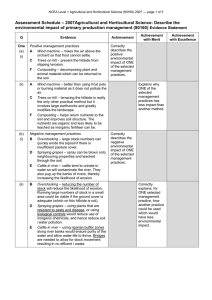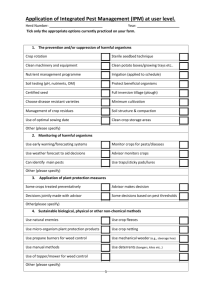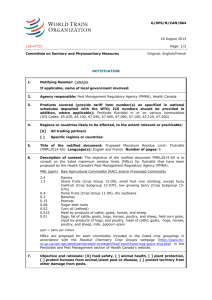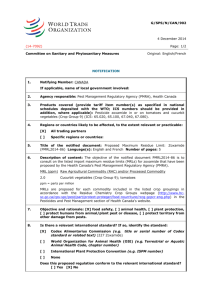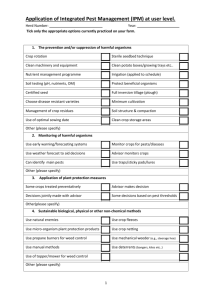Assessment Schedule – 2010
advertisement
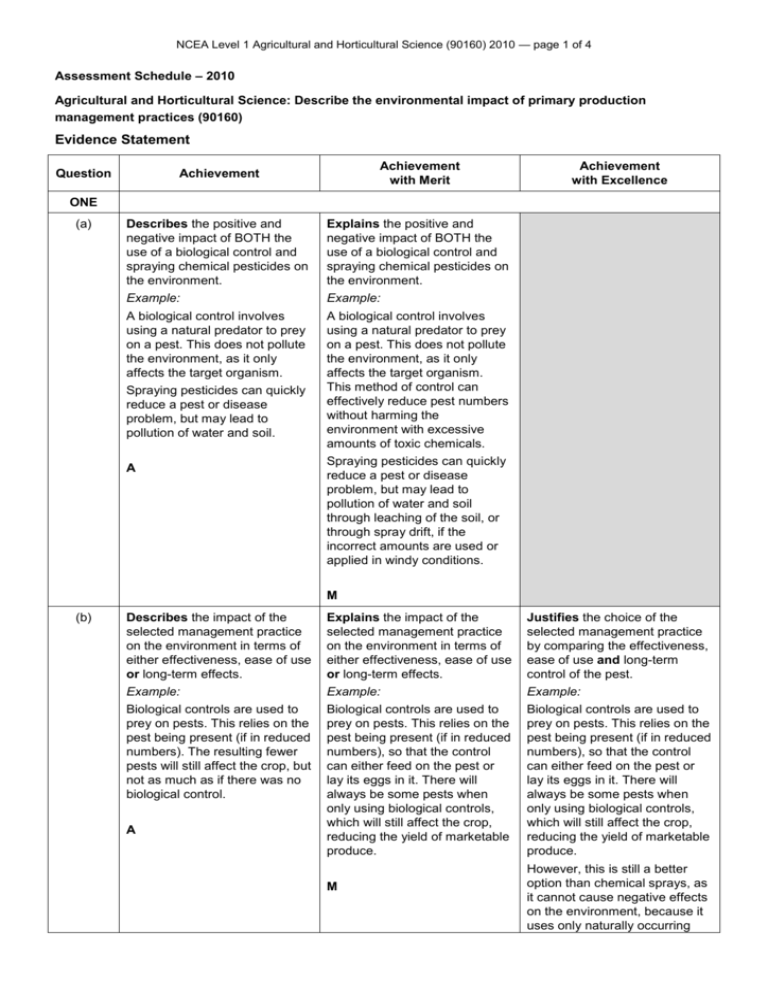
NCEA Level 1 Agricultural and Horticultural Science (90160) 2010 — page 1 of 4 Assessment Schedule – 2010 Agricultural and Horticultural Science: Describe the environmental impact of primary production management practices (90160) Evidence Statement Achievement Achievement with Merit Describes the positive and negative impact of BOTH the use of a biological control and spraying chemical pesticides on the environment. Explains the positive and negative impact of BOTH the use of a biological control and spraying chemical pesticides on the environment. Example: Example: A biological control involves using a natural predator to prey on a pest. This does not pollute the environment, as it only affects the target organism. A biological control involves using a natural predator to prey on a pest. This does not pollute the environment, as it only affects the target organism. This method of control can effectively reduce pest numbers without harming the environment with excessive amounts of toxic chemicals. Question Achievement with Excellence ONE (a) Spraying pesticides can quickly reduce a pest or disease problem, but may lead to pollution of water and soil. A Spraying pesticides can quickly reduce a pest or disease problem, but may lead to pollution of water and soil through leaching of the soil, or through spray drift, if the incorrect amounts are used or applied in windy conditions. M (b) Describes the impact of the selected management practice on the environment in terms of either effectiveness, ease of use or long-term effects. Explains the impact of the selected management practice on the environment in terms of either effectiveness, ease of use or long-term effects. Justifies the choice of the selected management practice by comparing the effectiveness, ease of use and long-term control of the pest. Example: Example: Example: Biological controls are used to prey on pests. This relies on the pest being present (if in reduced numbers). The resulting fewer pests will still affect the crop, but not as much as if there was no biological control. Biological controls are used to prey on pests. This relies on the pest being present (if in reduced numbers), so that the control can either feed on the pest or lay its eggs in it. There will always be some pests when only using biological controls, which will still affect the crop, reducing the yield of marketable produce. Biological controls are used to prey on pests. This relies on the pest being present (if in reduced numbers), so that the control can either feed on the pest or lay its eggs in it. There will always be some pests when only using biological controls, which will still affect the crop, reducing the yield of marketable produce. A M However, this is still a better option than chemical sprays, as it cannot cause negative effects on the environment, because it uses only naturally occurring NCEA Level 1 Agricultural and Horticultural Science (90160) 2010 — page 2 of 4 organisms. Once the predators are established, they can largely look after themselves and do not require regular attention by the grower. This makes them relatively easy to use, and they provide a long-term solution for controlling pests. E Question Achievement with Merit Achievement Achievement with Excellence TWO Describes a management practice that would reduce the negative impact of crop stubble burning on the environment. Explains a management practice that would reduce the negative impact of crop stubble burning on the environment. Example: Example: Minimum tillage could be used. This involves sowing the next crop through the residue of the previous crop. Minimum tillage could be used. This involves sowing the next crop through the residue of the previous crop. The crop stubble acts as a blanket, protecting the ground from erosion and reducing evaporation. There is obviously no air pollution from smoke using minimum tillage. A M Justifies the use of a management practice that would reduce the negative impact of crop stubble burning on the environment. Example: Minimum tillage could be used. This involves sowing the next crop through the residue of the previous crop. The crop stubble acts as a blanket, protecting the ground from erosion and reducing evaporation. This will allow the new crop to germinate successfully and reduce the initial reliance on irrigation. Minimum tillage is a better management practice than burning crop stubble, because it will reduce air pollution and soil erosion. Also, the soil structure will remain strong, due to minimum disturbance. E NCEA Level 1 Agricultural and Horticultural Science (90160) 2010 — page 3 of 4 Question Achievement with Merit Achievement Achievement with Excellence THREE (a) Describes the impact of spraying effluent and using settling ponds on the environment. Explains the impact of spraying effluent and using settling ponds on the environment. Example: Spraying effluent onto paddocks allows the nutrients to be used as a natural fertiliser. The nutrients will not be washed away, which reduces the need for fertiliser application. This reduces the nutrient loading on the waterways and prevents excessive algal growth. Spraying effluent onto paddocks allows the nutrients to be used as a natural fertiliser. The nutrients will not be washed away to pollute waterways. Using settling ponds results in a heavy sludge that can be used as a natural fertiliser instead of applying artificial fertilisers. A Example: Using settling ponds allows the heavy sludge to be used as a natural fertiliser, which reduces dependence on artificial fertilisers. Sunlight acts as a disinfectant that can kill pathogenic organisms, resulting in runoff that is relatively safe to allow into local waterways. M (b) Describes the impact of spraying effluent and using settling ponds on the environment. Explains the impact of spraying effluent and using settling ponds on the environment. Example: Spraying effluent onto paddocks allows the nutrients to be used as a natural fertiliser. The nutrients will not be washed away, which reduces the need for fertiliser application. This reduces the nutrient loading on the waterways and prevents excessive algal growth. Spraying effluent onto paddocks allows the nutrients to be used as a natural fertiliser. The nutrients will not be washed away to pollute waterways. Using settling ponds results in a heavy sludge that can be used as a natural fertiliser instead of applying artificial fertilisers. A Replacement evidence for 3(a) if required. Example: Using settling ponds allows the heavy sludge to be used as a fertiliser. This reduces dependence on artificial fertilisers. Sunlight acts as a disinfectant that can kill pathogenic organisms, resulting in runoff that is relatively safe to allow into local waterways. M Replacement evidence for 3(a) if required. Justifies the use of a management practice that would reduce the negative impact of effluent disposal on the environment. Example: Using settling ponds is the best management practice, as it allows the material to be used for fertiliser without fear of contamination of local waterways. The effluent is simply pumped from the dairy shed to the ponds, and from there it is mechanically pushed by water wheels through the pond system and trickles out into a planted area before it reaches a local waterway. This ensures that few nutrients reach the waterway and is relatively pathogen-free. Although it takes up land, the long-term benefits outweigh the slight loss of any productive area. It is a better method than spraying onto a paddock, as the nutrients and pathogens may be either leached or run off into waterways, depending on soil NCEA Level 1 Agricultural and Horticultural Science (90160) 2010 — page 4 of 4 type and weather. Also, a paddock cannot be grazed for 10 days after it has been sprayed, which restricts production. E Judgement Statement Achievement Achievement with Merit Achievement with Excellence 2A 2M 1M 1E
